
Issue #23/104, Nov 23 - Dec 7, 2000 

EXILE SPORTS NOTES
 THE
ALLEN IVERSON SPORTS SYLLOGISM OF THE WEEK
THE
ALLEN IVERSON SPORTS SYLLOGISM OF THE WEEK
‘Sup, sports fans! Welcome to Allen Iverson’s Sports Syllogism of the Week. Like many of you fans out there-both those in Philadelphia and in other cities-I frequently use multiple categorical propositions to fashion logical arguments. Typically in these instances, I use what we in the NBA call the categorical syllogism, which is just a fancy pro name for the everyday syllogism we all used on our neighborhood courts growing up. As in all syllogisms, the classical categorical syllogism is an argument consisting of three categorical propositions, each of which is used exactly twice. For instance:
All tattoos are dope.
I have crazy tattoos.
Therefore, all my tattoos are dope.
In this issue, I’m going to teach you how we sketch out certain kinds of categorical syllogisms in practice. You may find this hard to believe, but starting at the Division 1-NCAA level, we basketball players actually learn to draw our logical arguments. Today, we’ll be drawing what coach Larry Brown calls a syllogism of the EIO-3 mood and figure. In this form of syllogism, you have an E major premise, an I minor premise, and an O conclusion. The “3” basically means that the third premise, what we call the “middle term” of the syllogism, is located in the subject terms of the first and second proposition. For instance, take this EIO-3 syllogism:
No Celtic can do me.
Some Celtics think they got game.
Therefore, some people who think they got game can’t do me.
Now let’s draw this argument.
(1) First, we draw and label the three overlapping circles needed to represent all three terms included in the EIO-3 syllogism.
(2) Second, we diagram each of the premises. Since the major premise is a universal proposition-no Celtic can do me-we may begin with it. The diagram from “No Celtic can do me” must shade in the entire area where the “Doing me” and “Celtic” circles overlap.
(3) Now we add the minor premise to our drawing. The diagram from “Some Celtics think they got game” puts an X inside the area where the “Celtic” and “Think they got game” circles overlap. But part of that area (the part inside the “Doing me” circle) has already been shaded, so our X must be placed in the remaining portion.

Now all we have to do is look at our picture. Remember, the simple proposition “Some people who think they got game can’t do me” would simply have two circles, with an “X” connoting the inability to do me within the circle for people who think they got game. Do we now have such a drawing? Yes, we do: there is an “X” in the appropriate circle, lying fully outside the “doing me” circle. Had we not shaded in part of that circle in step two, we couldn’t have been so sure.
Join me next week for a look at the AAA-2 (invalid) form. Until then, let me hear ya say yeah! Sixaz for life!
Cards |
Links |
The Vault |
Gallery |
Who? |